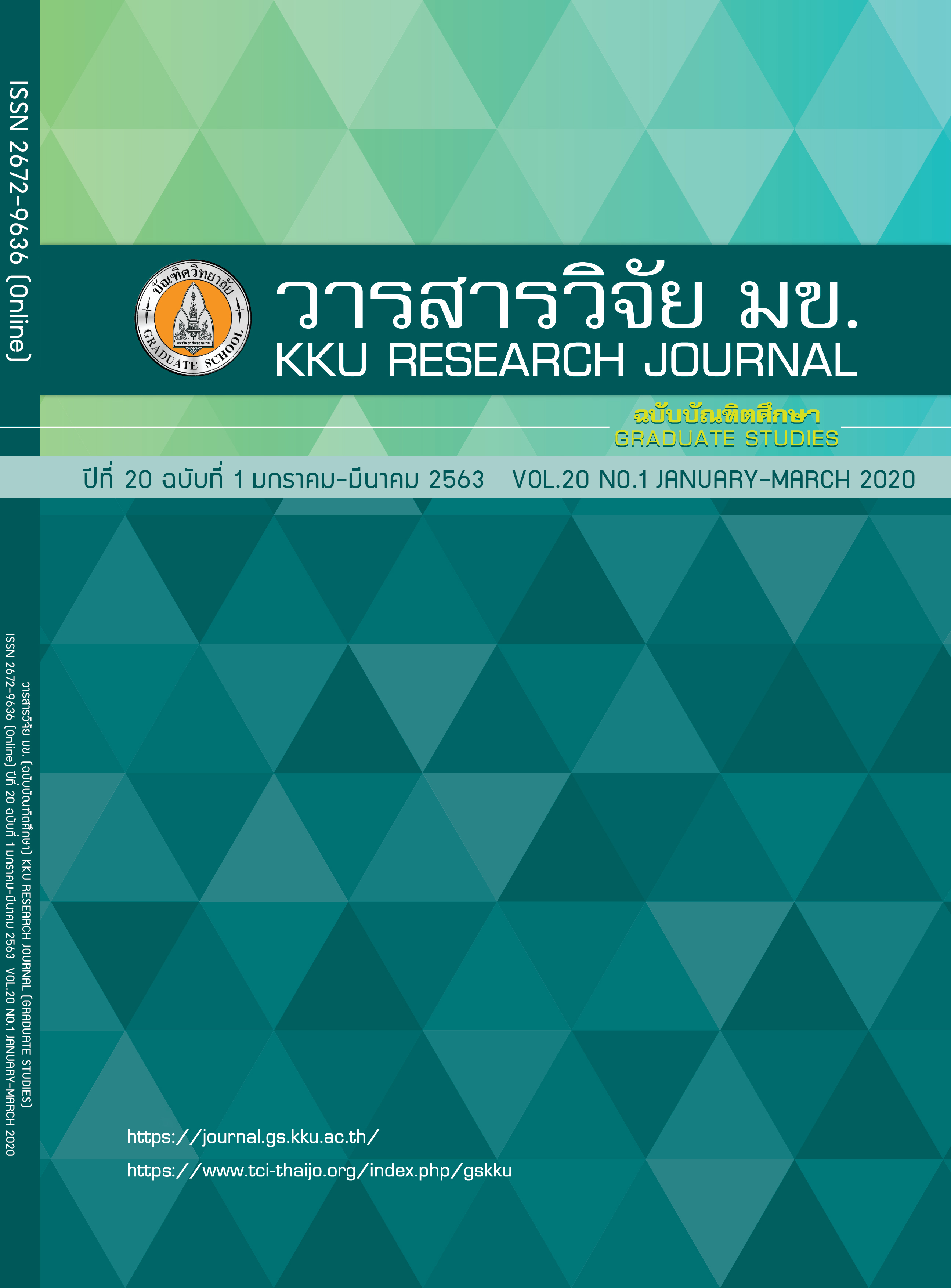Optimization of Tannin Gel Synthesis from Eucalyptus Bark Extract
Keywords:
Resin, Methylene blue, AdsorbentAbstract
The objective of this research was to evaluate the optimal condition for tannin gel synthesis from Eucalyptus bark extract. The central composite design (CCD) was used to design the experiments and response surface methodology (RSM) was used to evaluate the optimal condition. The effects of mass ratio of formaldehyde to tannin and the reaction temperature on adsorption performance of synthesized tannin gel were investigated. Tannin gel was tested with initial Methylene blue (cationic dye) concentration of 20 ppm and dosage tannin gel of 20 mg. It was found that main variables have an effect on Methylene blue removal significantly (P-value < 0.05) while the interaction between variables were not significant (P-value > 0.05). The optimum condition was obtained at mass ratio of formaldehyde to tannin of 3.1:1 and the reaction temperature of 80 ๐C. The adsorption isotherm was fitted with the Langmuir adsorption model with the maximum adsorption capacity of 135 mg/g. The tannin gel synthesized from Eucalyptus bark extract has a potential to use as an adsorbent for removal of cationic dye from aqueous solutions.
References
Bacelo HAM, Santos SCR, Botelho CMS. Tannin-based biosorbents for environmental applications – A review. Chemical Engineering Journal. 2016; 303: 575–587.
Maria Rahman M, Akter N, Karim MR, Ahmad N, Rahman MM, Siddiquey IA, et al. Optimization, kinetic and thermodynamic studies for removal of Brilliant Red (X-3B) using Tannin gel. Journal of Environmental Chemical Engineering. 2014; 2(1): 76–83.
Alvares Rodrigues L, Koibuchi Sakane K, Alves Nunes Simonetti E, Patrocínio Thim G. Cr total removal in aqueous solution by PHENOTAN AP based tannin gel (TFC). Journal of Environmental Chemical Engineering. 2015; 3(2): 725–733.
Sánchez-Martín J, Beltrán-Heredia J, Gibello-Pérez P. Adsorbent biopolymers from tannin extracts for water treatment. Chemical Engineering Journal. 2011; 168(3): 1241–1247.
Can M, Bulut E, Örnek A, Özacar M. Synthesis and characterization of valonea tannin resin and its interaction with palladium (II), rhodium (III) chloro complexes. Chemical Engineering Journal. 2013; 221: 146–158.
Yi Q, Fan R, Xie F, Min H, Zhang Q, Luo Z. Selective Recovery of Au(III) and Pd(II) from Waste PCBs Using Ethylenediamine Modified Persimmon Tannin Adsorbent. Procedia EnvironmentalSciences. 2016; 31: 185–194.
Xie F, Fan Z, Zhang Q, Luo Z. Selective adsorption of Au 3+ from aqueous solutions using persimmon powder-formaldehyde resin. Journal AppliedPolymerScience. 2013; 130(6).
Kunnambath PM, Thirumalaisamy S. Characterization and Utilization of Tannin Extract for the Selective Adsorption of Ni ( II ) Ions from Water. Journal of Chemistry. 2015.
Shirato W, Kamei Y, Insoluble tannin preparation process, waste treatment process employing insoluble tannin and adsorption process using tannin, US patent 5,158,711(1992).
Adthalungrong C, Saechua N, Doungkaew K. Lactic Acid Fermentation from Tapioca Starch by Lactobacillus casei TISTR 453 using Simultaneous Saccharification and Fermentation Process. KKU Res. J. 2014; 19(3): 125–133.
Kokkaew H, Srithanyarat N, Pitirit T. Optimization of Anthocyanin and Effects of Acidulants on Phytochemicals and Antioxidant Activities in Purple Waxy Corn Cookies. KKU Res. J. 2015; 20(1): 75–90.
Vieira RC, Santos SCR, Boaventura RAR, Bacelo H, Botelho MS. Recovery and valorization of tannins from a forest waste as an adsorbent for antimony uptake. Journal of Cleaner Production. 2018; 198: 1324–1335.
Zhao M, Jing J, Zhu Y, Yang X, Wang X, Wang Z. Preparation and performance of lignin–phenol–formaldehyde adhesives. Int J Adhes Adhes. International Journal of Adhesion and Adhesives. 2016; 64: 163–167.
Uddin T, Islam A, Mahmud S. Adsorptive removal of methylene blue by tea waste. Journal of Hazardous Materials. 2009; 164: 53–60.
Do M, Abak H, Alkan M. Adsorption of methylene blue onto hazelnut shell : Kinetics , mechanism and activation parameters. Journal of Hazardous Materials. 2009; 164: 172–181.
Ritthichai A, Muncharoen S. Dye Removal of Textile Wastewaters using Crab Shell Activated Carbon. Burapha Sci. J. 2014; 131-140.



